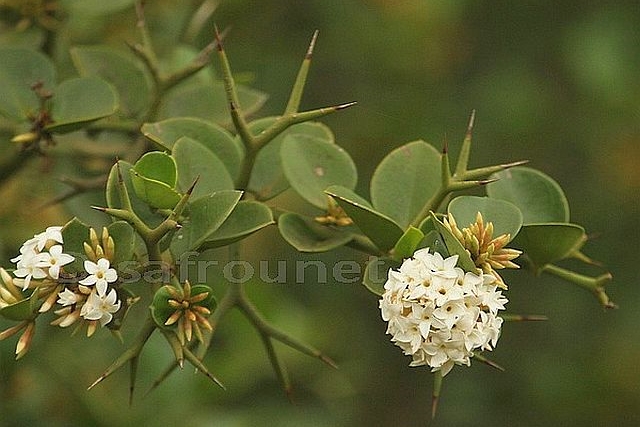Order: Gentianales. Family: Apocynaceae
 © nan
© nanBontebok National Park
Description
This species is only occasionally tree-like (up to 5 m) and is more often a dense multi-stemmed or rambling shrub. It is evergreen and twiggy, the branches exhibiting a repeated forked pattern. The bark is wrinkled, dark brown or grey in older trees, but younger stems, branchlets and twigs are green and fleshy. The plants contain a milky sap and the branches are often hairy. Spines (45 mm) are once- or twice-forked, rarely single, and are sometimes even absent.
Simple thick leaves (10 - 70 mm x 8 - 35 mm) are crowded towards the end of the twigs. Leaves are opposite, shortly petiolate, ovate, broadly ovate or ovate-elliptic, with a smooth margin, glossy dark green above, paler below, with short, thorn-like tips (heart-shaped tapering to a sharp point).
Flowers (Aug - Jan) are sweet-scented and small (petals: 5 mm; tube 9 mm), white or tinged pink, with a long, slender corolla tube, sweetly scented and clustered at the tips of twigs. Fruit are small, ovoid, edible, red berries. The whole fruit, including the seed, is edible and although the skin is slightly milky, it has a delicious flavour. It is not uncommon to find fruit and flowers on the same plant.
Distribution
Carissa bispinosa is found from the southwestern parts of the Western Cape along the coastal areas right through the Eastern Cape, KwaZulu-Natal into Gauteng and the northern provinces. It also occurs in the eastern Free State, Lesotho, Swaziland, Zimbabwe and Mozambique extending westwards to Botswana and Namibia and sporadically further north as far as Kenya. The leaves and thorns in particular, show marked variation throughout the distribution range.
Provincial distribution in South Africa: Eastern Cape, Gauteng, KwaZulu-Natal, Limpopo, Mpumalanga, North West, Western Cape.
Habitat
In wooded areas: dry woodland, coastal scrub and forest margins.
Links: Trees and Shrubs of Mpumalanga and Kruger National Park. Ernst Schmidt, Mervyn Lotter, Warren McCleland; Sappi Tree Spotting: Highlands Highveld, Drakensberg Eastern Cape Mountain. Rina Grant, Val Thomas



 © nan
© nan